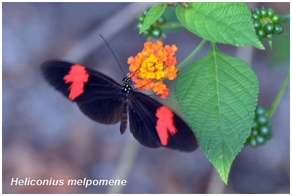Honest signalling and the billboard effect: how Heliconiid pollinators respond to the trichromatic colour changing Lantana camara L. (Verbenaceae)
DOI:
https://doi.org/10.26786/1920-7603(2017)threeAbstract
Plants communicate with their pollinators through an astonishing range of signals that serve as either honest or deceptive cues which draw in and inform potential visitors of possible rewards. In wild type sweet sage, Lantana camara, floral colour signals were associated with nectar volume and sucrose concentration, and many pollinator taxa quickly learned to associate these varying colour signals with rewards. We tested the hypothesis that if sweet sage is employing a generalist pollinator strategy based on a trichromatic changing floral presentation system of honest rewards for pollinators, then the following predictions will be realized: 1) pre-change yellow flowers will be visited more frequently by pollinators than post change orange, or red flowers; 2) pre-change yellow flowers will produce higher quality and greater quantities of sucrose rewards than post-change orange, or red flowers; 3) inflorescences with higher ratios of rewarding flowers to unrewarding flowers are more attractive at short distances; and 4) inflorescences with a combination of pre-change rewarding and post-change rewarding and unrewarding flowers will act as a multi-coloured advertising billboard and as such be most attractive at long distances. We found corroboration for all of the aforementioned predictions. Thus, sweet sage evolved a generalized pollination visitation system based on honest signalling―of reward quantity and quality tied to colour changing visual signals acting in consort to produce a billboard that was easily perceived and deciphered. These resulted in high visitation rates by many different taxa of pollinators, thus contributing to higher individual plant fitness.

Downloads
Published
How to Cite
Issue
Section
License
Copyright (c) 2017 Gyanpriya Maharaj, Godfrey Bourne

This work is licensed under a Creative Commons Attribution 4.0 International License.
JPE is an open access journal which means that all content is freely available without charge to the user or his/her institution.
Authors who publish with this journal agree to the following terms:
1) Authors retain copyright and grant the journal right of first publication with the work simultaneously licensed under a Creative Commons Attribution License that allows others to share the work with an acknowledgement of the work's authorship and initial publication in this journal.
2) Authors are able to enter into separate, additional contractual arrangements for the non-exclusive distribution of the journal's published version of the work (e.g., post it to an institutional repository or publish it in a book), with an acknowledgement of its initial publication in this journal.
3) Authors are permitted and encouraged to post their work online (e.g., in institutional repositories or on their website) prior to and during the submission process, as it can lead to productive exchanges, as well as earlier and greater citation of published work (See The Effect of Open Access).
To assure a broader targeted audience, content will be included into databases (such as EBSCO) and directories (such as DOAJ).











